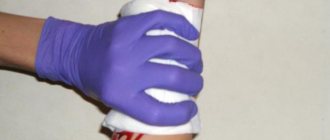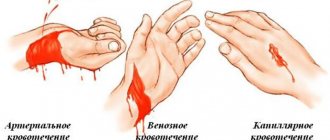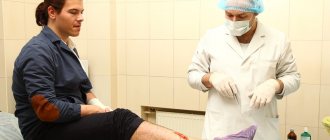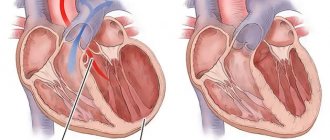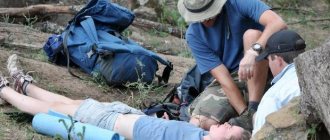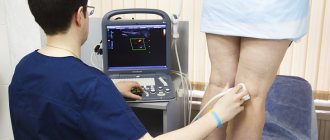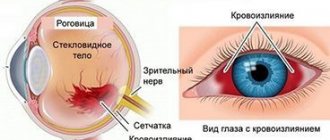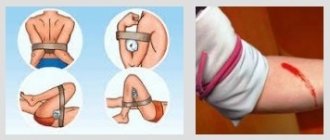Loss of blood is a very dangerous phenomenon that can lead to death in a short time. Without the timely provision of specialized care, the chances of survival with major blood loss are lost every minute. This necessitates the need to have basic first aid skills that can save a person. In this article we will pay attention to venous bleeding, its features, and first aid techniques.
Stopping venous bleeding is one of the most important first aid skills, as damage to large vessels can lead to massive blood loss and death in a matter of minutes.
Specifics and signs of venous bleeding
Specifics and signs of venous bleeding
Veins are a network of vessels that move blood from internal organs to the heart muscle.
Signs of bleeding that occurs due to mechanical damage to the veins are: - dark - brown color of blood (unsaturated with oxygen, unlike cases of arterial bleeding) - smooth, non-pulsating flow - pallor and lethargy of the injured person Venous bleeding can be determined by pressing on the vein near the bleeding wound - with venous bleeding, blood loss will be sharply reduced. Depending on the location of the wound, the nature of first aid varies somewhat, therefore, having identified the source of bleeding, it is necessary to quickly implement an algorithm for providing assistance. Basic rules for providing first aid step by step, ways to stop
What is the main danger of capillary bleeding?
First aid for capillary bleeding should not be called an unnecessary procedure. Compared to arterial and venous bleeding, capillary bleeding is not so dangerous, and in most cases the body copes with it on its own. But there are situations that are life-threatening:
- the skin is extensively damaged;
- the ambient temperature is increased;
- blood clotting is impaired;
- There is blood poisoning, oncology, hepatitis, arterial hypertension and other severe pathologies.
The most dangerous is bleeding as a result of damage to the blood vessels of internal organs. Prolonged bleeding provokes a decrease in blood pressure, oxygen starvation, and disruption of the cardiovascular system. If the blood loss is severe, the person dies without treatment. Hemorrhage in the brain affects important centers and also leads to a fatal outcome. Pleural bleeding disrupts breathing and puts pressure on the lung. In most cases, it is important to react in time to manifestations of capillary bleeding and provide first aid in a timely manner.
Basic rules for providing first aid step by step, ways to stop
Generally accepted actions when venous bleeding is detected are as follows:
- The sections of the vein above and below the injury site must be clamped as close to the bone as possible. To clamp the vein, a tourniquet, thick fabric and similar improvised means are used; in the absence of means, clamping is done with the fingers.
- The wound must be covered with cotton wool or a piece of fabric - this will prevent air bubbles from entering the vein and prevent further development of air embolism.
- If possible, it is necessary to apply ice or any cold object to the wound site that helps slow down the flow of blood circulation.
- Calling an ambulance or any action to hospitalize the victim as quickly as possible. Specific algorithms for providing assistance
In addition to the general rules for providing assistance with venous bleeding, there are some specific rules that apply depending on the location of the vein damage. Damage to the distal segments located at a distance from the body poses less danger than bleeding from the proximal areas. Measures for bleeding from distal segments (hands and feet, forearm) are as follows: - Pressing the vein with your fingers, in the area below the wound - The damaged limb must be raised above the level of other limbs - The open wound must be clamped with a cotton swab dipped in hydrogen peroxide - If possible, it is necessary to apply a compressive fabric bandage. Measures to stop bleeding from the proximal area (thigh, shoulder): - The damaged area must be elevated - Application of a pressure bandage necessary to reduce the flow of bleeding - Mandatory application of a tourniquet - When visually stopping the bleeding, the tourniquet is removed, the wound is tamponed, and a pressure bandage is applied again.
A way to stop venous bleeding is to apply a tourniquet
What is it characterized by and how to stop bleeding from superficial veins
Circulatory disturbance cannot be caused even by complete transection of any saphenous vein. However, despite the secondary importance of this group of vessels, even such venous bleeding can lead to a critical amount of blood loss.
Therefore, it is necessary to know the places at risk in this regard:
- Venous network of the wrist,
- The great vein of the thigh and leg with main tributaries located in the internal portion of these segments,
- Central veins of the outer and inner surfaces of the shoulder and forearm,
- Venous plexuses on the dorsum of the foot.
Venous bleeding caused by injuries in the listed places has the following clinical symptoms and features:
- More bleeding is observed from the lower end of the affected vein, which is explained by the centripetal direction of blood flow (upward),
- In case of damage to the subcutaneous small veins , they are able to thrombose on their own, resulting in spontaneous cessation of bleeding,
- Damage to the main veins of the shoulder and thigh can extremely rarely result in spontaneous stopping of bleeding,
- Increased bleeding can be caused by alcohol intoxication, high blood pressure, diseases of the blood system (thrombocytopenia, hemophilia, leukemia).
These circumstances predetermine the provision of first aid and the final stop of bleeding from the subcutaneous vessels.
A way to stop venous bleeding is to apply a tourniquet
Half the success of the fight against venous bleeding depends on the correct application of the tourniquet. Therefore, you should know how this measure of medical care is carried out.
- The tourniquet should be applied below the injury site, as close as possible to the wound itself.
- It is necessary to place a piece of bandage or fabric under the applied tourniquet to prevent damage to the skin.
- The tourniquet is applied by quickly wrapping the limb and tightening
- The exposure time of the tourniquet cannot exceed 1.5 hours, therefore, immediately after stopping the bleeding, the victim should be hospitalized as quickly as possible.
Bleeding in the veins of the neck
Types of bleeding
Most often, bleeding is grouped according to anatomical principles, taking into account the damaged blood vessel.
According to this classification, there are 3 main types of bleeding :
- Arterial. The blood stream is pulsating and scarlet in color. It is characterized by a high rate of blood loss and is the most dangerous.
- Venous. The blood is dark and may flow more slowly.
- Capillary. The blood is bright red, appears slowly and in a small volume. Sometimes it appears in the form of small drops on the surface of the skin.
Separate topic: Types of external bleeding
There is also parenchymal bleeding, which cannot be seen. It occurs when the integrity of the liver, pancreas, and kidneys is damaged. Parenchymal bleeding is similar in nature to capillary bleeding, but poses a great danger to life. With deep penetrating wounds or damage to the integrity of internal organs, bleeding can be mixed.
Internal and external bleeding are also distinguished according to the direction of blood release. In the first case, blood accumulates in the cavities of the body, in the second, it comes out through wounds.
We recommend additional material: First aid for wounds
Bleeding in the veins of the neck
Why is damage to the veins in the neck dangerous?
- Without professional skills, it is impossible to apply a bandage without causing suffocation in the victim;
- vessels in the neck area are large in diameter, their injuries cause profuse and rapid blood loss, so first aid must be provided as quickly as possible;
- Air can be sucked into the lumen of a large vessel, resulting in the formation of an air plug (embolism), which can cause death.
How to stop bleeding if your neck is injured:
- Lay the person down so as to provide easy access to the wound.
- If possible, apply a cotton or gauze cloth folded several times and soaked in antiseptic (hydrogen peroxide) to the wound.
- Press the area above and below the injury with three fingers (ring, middle and index) of both hands folded together.
You can consider that you have achieved results if the bleeding has stopped or greatly weakened, but the pulsation of deep vessels is felt under your fingers.
Nose bleed
Causes of bleeding
The following factors can cause bleeding:
- mechanical damage to blood vessels;
- neoplasm or inflammatory process in the walls of blood vessels;
- deterioration of the integrity of blood vessels due to infection, lack of vitamins or poisoning of the body.
Remember that timely assistance with bleeding can save the victim’s life!
1 Help with bleeding. Types of bleeding
2 Help with bleeding. Types of bleeding
3 Help with bleeding. Types of bleeding
Nose bleed
A strong flow of blood from the nose is stopped in this way:
- the victim must sit down so that blood can flow freely from the nose: tilting his head down slightly;
- to stop the bleeding, you need to clamp the damaged vessels by pressing on the wings of the nose on both sides for 5 minutes (if the cause is not a fracture);
- any cold object is applied to the bridge of the nose: a wet handkerchief, ice, snow;
- if the blood cannot be stopped within 15 minutes, turundas from a rolled-up bandage are inserted into both nostrils;
- It is strictly forbidden to throw back your head, suck in blood through your nose, or swallow it: vomiting may occur.
AGAIN POINT BY POINT
Emergency care for arterial bleeding
Remember that in case of arterial bleeding you cannot hesitate!
Quickly assess the situation and proceed to provide assistance. First of all, pinch the artery with your finger:
If bleeding is in the face area, press your finger on the corner of the lower jaw.
If bleeding is from the head area, then press your finger on the temporal bone in front of the ear.
If bleeding is in the area of the shoulder joint, then press the subclavian artery to the rib.
If bleeding is in the area of the hand, then press the brachial artery to the bone from the side of the shoulder.
If there is bleeding in the thigh area, then you need to press your fist on the frontal bone in the groin area.
Next you need to apply a tourniquet. To temporarily stop arterial bleeding, an Esmarch tourniquet or improvised rubber material is used. Rules for applying a tourniquet:
- Raise, if possible, the victim's arm/leg - this will lead to the outflow of venous blood from the limb;
- Place the tourniquet over the victim’s clothing or a piece of fabric: this is necessary so as not to injure the person’s skin.
- The first 2 turns need to be made the tightest, the crosshair is applied on the back side of the artery. Make sure that the bleeding from the wound has stopped and the skin below the tourniquet has turned pale.
- The victim should be immediately sent to the hospital or call an ambulance.
If you do not achieve complete disappearance of the pulse on the radial artery, then within 10-15 minutes the hand will swell and turn blue. Then the tourniquet can be removed only if the arm is amputated. Record the time of application of the tourniquet. The maximum permissible time in summer is 90 minutes, in winter – 60 minutes, otherwise tissue necrosis occurs.
Every 30-40 minutes, regardless of the time of year, you should remove the tourniquet for 20-30 seconds (until the skin below its application turns pink). This is done so that blood can enter the damaged limb to supply it with oxygen and remove metabolic products.
Then the tourniquet should be applied again below or above its previous location. You can do this for several hours.
AGAIN POINT BY POINT
- It is necessary to find the location of the damage.
- Raise and secure the limb.
- There is no time to clean and disinfect the wound if there is heavy blood loss - it is important to stop it, so ask the victim to press the vein with his hand below the injury site or do it yourself.
- A pressure bandage is applied below the cut or puncture site and can be made from any dressing material that is at hand: a bandage, a piece of clean cotton fabric, a handkerchief.
- Before you start bandaging, you need to place a cloth folded several times below the cut site, this way, when applying a bandage, you will achieve the necessary pressure on the lumen of the damaged vessels to reduce bleeding.
- The bandage should be made several times around the limb, starting from a thinner place. A positive result of first aid for venous bleeding is if the bleeding has stopped and the pulse can be felt below the bandage. This means that you managed to reduce the lumen of the blood vessels, but did not disrupt the blood supply.
- The victim must be taken to the hospital within 2 hours (in winter this period is halved) since an incorrectly applied, too tight bandage can cause tissue necrosis.
When small venous vessels are damaged, spontaneous formation of a blood clot occurs, and the bleeding stops on its own or after applying a pressure bandage. The blood loss in this case is small and is usually not life threatening. However, only a doctor can give a general assessment of the victim’s condition.
In case of damage to medium and large veins (jugular, subclavian and femoral), a favorable prognosis depends on timely assistance. Blood loss in a short time (30 to 50 minutes) can be fatal. A serious complication is the filling of the bed with an air plug (the vein fills with air during inhalation, when negative pressure is formed in it), which can lead to death from embolism earlier than from blood loss.
When providing first aid successfully, you need to remember that it is possible to finally stop bleeding from damaged vessels only in a medical institution.
Bleeding from varicose veins
Is the situation familiar? You come to the doctor, show your varicose veins on your legs, ask a bunch of questions, get recommendations for treatment and put the problem on the back burner. Naturally, if according to an ultrasound examination the veins do not work, the phlebologist offers you surgical treatment. But you are not in a hurry to have surgery, maybe it will do. Many patients faced with varicose veins are in no hurry to consult a doctor about this problem. One of the most dangerous complications of varicose veins, which we will consider in this article, is bleeding from varicose veins on the legs.
Causes of variceal bleeding
It is no secret that with varicose veins, the wall of the vein becomes very thin due to its stretching. It is expressed externally as bluish varicose nodes protruding above the surface of the skin. In the absence of proper treatment and failure to follow the doctor’s recommendations, the walls of the veins become so thin that even with minor traumatic damage, quite severe bleeding can occur. Due to blood loss, a person may die without waiting for an ambulance doctor. The most problematic area where bleeding most often occurs is the nodular veins in the ankles and legs.
Factors causing bleeding:
- Violation of the integrity of the skin at the site of varixes (nodes) - punctures, abrasions, blows, cuts.
- Tears of veins due to increased physical activity, during sports activities.
- Damage to veins due to diseases: hypertensive crisis, severe cough (with pneumonia, bronchitis), during physiological labor (with straining).
- When veins are squeezed by tight, uncomfortable clothing, venous pressure rises sharply and the vessel bursts.
Clinical picture
Traumatic
As a result of damage to the skin of the legs in the area of varicose veins. Even a small cut at the site of the node can be a source of heavy bleeding. To reduce venous pressure, you must take a horizontal position. It must be remembered that it is impossible to stop bleeding while standing.
Spontaneous
Sudden (spontaneous) rupture of the venous walls for no apparent reason. In the vast majority of cases, the risk zone includes patients with advanced varicose veins, with a pronounced pattern of protruding veins, especially in the stage of trophic ulcers.
Subcutaneous
The name speaks for itself. Rupture of a venous vessel without damaging the skin. It can also be spontaneous and traumatic. Depending on the size of the damaged vessel - intense and light. Outwardly it looks like a hematoma (bruise). If the patient knows that there were no bruises, but bruises begin to appear in the area of varicose veins, he should immediately consult a doctor.
External
It is always accompanied by a violation of the integrity of both varicose veins and the skin itself over them. As a rule, these bleedings are always heavy.
A characteristic feature of bleeding from varicose veins in the legs is the absence of pain.
What is the danger?
Due to the lack of pain, a person does not notice the moment of bleeding. When blood is detected on the body, the instinct of self-preservation awakens in us, adrenaline is released into the blood - which causes blood pressure to rise, the pulse to quicken - all this leads to an even greater release of blood from the damaged vessel, as a result of which shock develops, leading to fainting and death. Such patients need to be given first aid as soon as possible even before the ambulance arrives.
First aid for bleeding from varicose veins of the lower extremities
If bleeding from varicose veins is detected, you must:
- remain calm, call an ambulance, follow the instructions listed below:
- In place of the damaged vein, you need to place a sterile gauze pad or a bandage folded several times; you can also use a hemostatic sponge. If you don’t have a first aid kit on hand, a clean, folded cloth will do.
- An elastic bandage should be applied over the bandage without creating strong compression.
- Apply an ice pack or a cold object to the affected area for 15-20 minutes (if there is no ice or cold objects, apply compression to the bleeding site with your fist).
- Lay the patient on his back and tilt his legs up while waiting for the ambulance to arrive.
- After the bleeding stops, you need to lie down for about 30 minutes with your legs raised. If the bleeding has stopped, you must remain in bed for the rest of the day.
- It must be remembered that a hemostatic tourniquet cannot be applied without appropriate qualifications. When applying a tourniquet above the source of venous bleeding, the process can be aggravated by even greater blood loss (these cases are quite common in medical practice).
Recovery period after blood loss
For several days after a bleeding episode, you should not take blood thinning medications (Aspirin, Cardiomagnyl, Thrombo-Ass, etc.). You need to control your blood pressure. Sudden rises from the bed are unacceptable (you need to rise slowly, first sit down on the bed, then try to stand up, holding the backrest). In the coming days, avoid taking hot baths, visiting a bathhouse, sauna, massage room, or lifting weights.
A few words about prevention
It is stupid to know about the problem and do nothing to solve it. Why wait for bleeding to appear from those vessels that will never function as before. If you have such veins in your legs, you don’t need to wait, but go to the doctor to solve the problem - there are many methods, from sclerotherapy to removal through small punctures (mini-phlebectomy). If you complain about swelling of the legs, night cramps, the appearance of spider veins on the lateral surface of the feet and legs, or heaviness in the calf muscles, you should immediately contact a phlebologist. Modern medicine has been making leaps and bounds in the field of phlebology over the past 2-3 years, and offers a lot of medicines and remedies for getting rid of varicose veins in the early stages.
To avoid bleeding from varicose veins, first of all, it is necessary to limit physical activity, follow a diet, and wear compression stockings. If bleeding from varicose veins does occur, you must urgently call an ambulance, remain calm, press the bleeding vessel with your fist, and, if possible, apply a bandage.
Not everyone can live on a “powder keg” and follow all the recommendations. All over the world, doctors and patients prefer modern methods of treating varicose veins - laser treatment or sclerotherapy (gluing).
Make an appointment with a phlebologist surgeon
Surgeon-phlebologist—Nisin Andrey Aleksandrovich
You can make an appointment by calling (391) 218−35−13 or through your personal account
